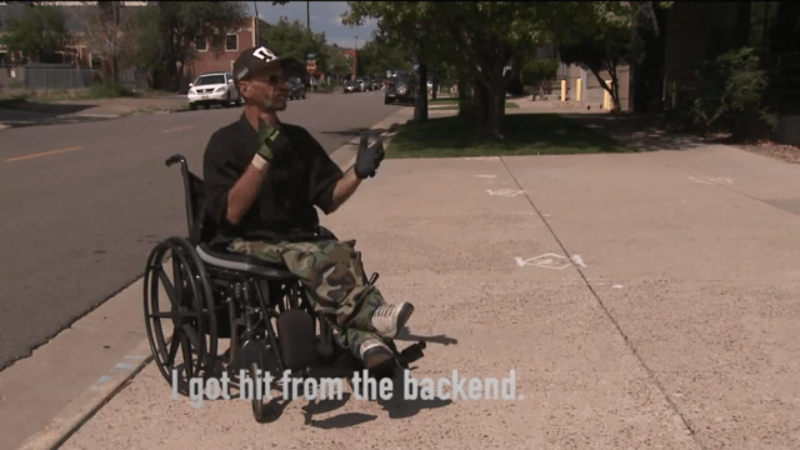Memo to Denver PD: Ticketing a Man in a Wheelchair Hit By Driver Is Not Vision Zero

Last month, an SUV driver struck Kyle Wolfe as he tried to cross 19th Street at Lawrence in his wheelchair, badly bruising his back. To add the proverbial insult to his injuries, Wolfe also received a citation from the Denver Police Department for crossing against the light.
Wolfe told Fox31’s Emily Allen that he entered the crossing with a walk signal, however, and had to pause to pick up some personal effects he dropped. He just didn’t have enough time to cross the four-lane, one-way street in the 20 allotted seconds before oncoming traffic got a green:
“When you are moving, everything is falling. I need to pick it up. People don’t want to stop,” Wolfe said.
Denver follows federal regulations that pedestrians travel at 3.5 feet per second. The time allotted for each intersection is based on the width of the intersection and how long it will take to cross traveling at that speed.
“That is not fast enough for a handicap person to get across a cross walk,” Wolfe said.
Denver PD shrugged off Wolfe’s account, telling Allen that he can fight the ticket in court. Lucky him.
Legally speaking, when a light turns green, it does not confer the right for drivers to mow down anyone who happens to be in their path at the moment. If Wolfe entered the intersection with the signal, he would have a strong legal case based on Colorado statute 42-4-802.
“I would fight this ticket,” said Brian Weiss, a local attorney who specializes in traffic crashes, especially when bicyclists and pedestrians are involved. “We have to accommodate people with disabilities, and [Wolfe] acted in good faith. I haven’t read the police report, but it sounds like he did not intend to violate a traffic control signal.”
Even if Wolfe began crossing against the light, he would have a case, Weiss said, based on precedent. “You always have to watch out for pedestrians,” he said. “Vehicles always have to yield.”
Denver PD did not cite the driver.
Beyond the strictly legal questions at play, something is deeply wrong with a system where someone in a wheelchair gets hurt while crossing the street, trying to follow the rules — and then fined. The spirit of Denver’s Vision Zero Action Plan, released last week, is to make this system more forgiving, especially for people who aren’t protected by the metal casing of a car.
The plan states that “law enforcement can play a greater role by ensuring traffic laws are enforced equitably across modes and communities within Denver, valuing education and engagement over penal justice.” Punishing a pedestrian after getting hurt is the antithesis of this principle.
The plan also states: “Vision Zero recognizes that humans make mistakes and therefore the transportation system be designed to minimize the consequences of those errors.” The problem is not Wolfe, the problem is a crossing phase that’s too short and should be lengthened.
Mayor Michael Hancock might want to remind Denver Police Chief Robert White that he signed up to prioritize the most vulnerable people on the street when he committed his department to Vision Zero — not penalize them.


